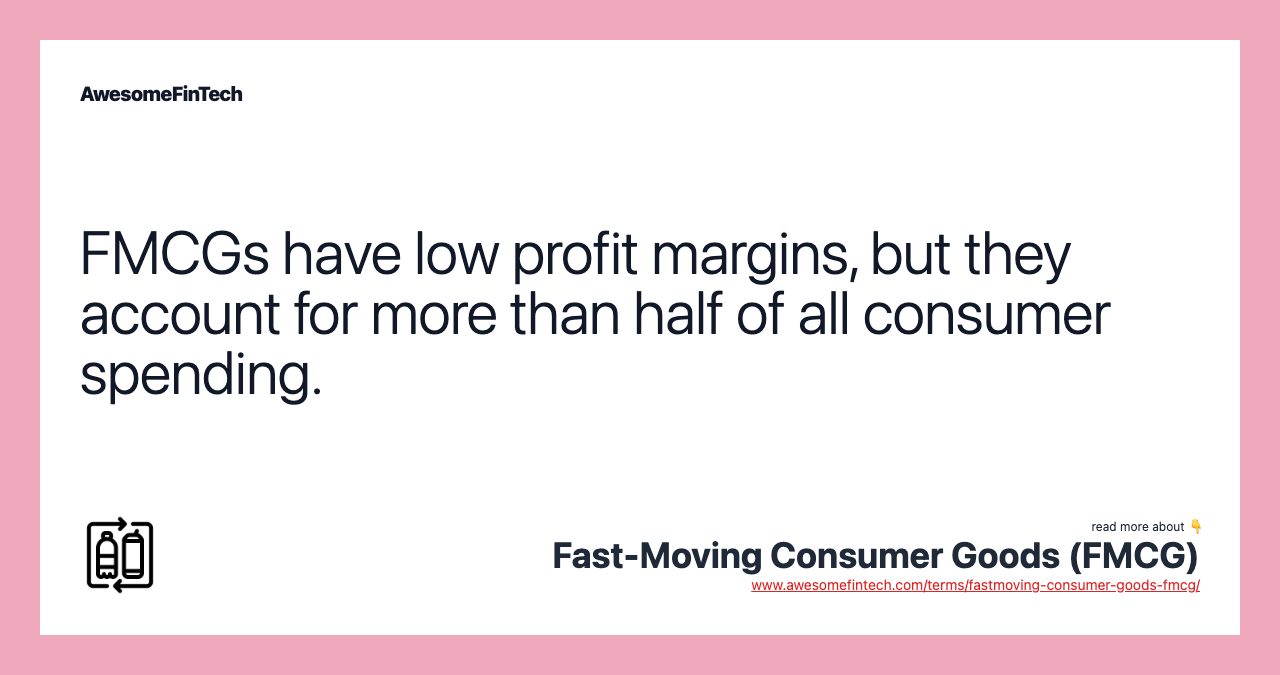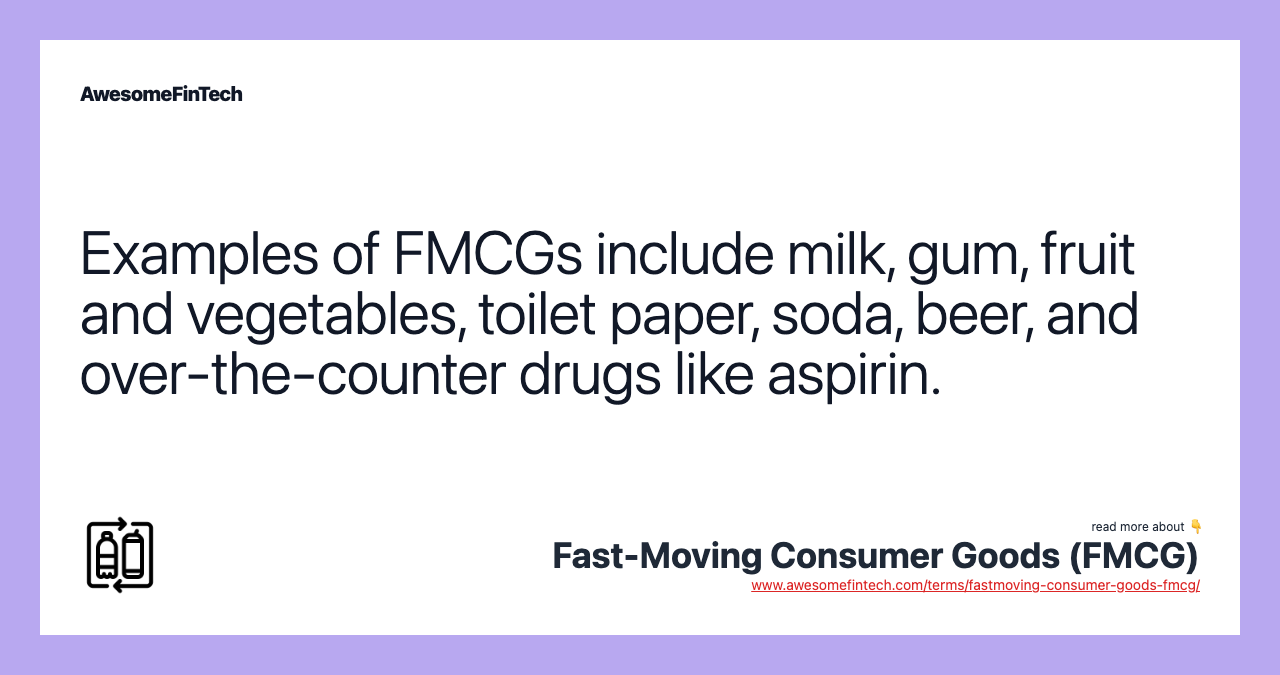Fast-Moving Consumer Goods (FMCG)
Fast-moving consumer goods are products that sell quickly at relatively low cost. FMCGs can be divided into several different categories including: **Processed foods**: Cheese products, cereals, and boxed pasta **Prepared meals**: Ready-to-eat meals **Beverages**: Bottled water, energy drinks, and juices **Baked goods**: Cookies, croissants, and bagels **Fresh, frozen foods, and dry goods**: Fruits, vegetables, frozen peas and carrots, and raisins and nuts **Medicines**: Aspirin, pain relievers, and other medication that can be purchased without a prescription **Cleaning products**: Baking soda, oven cleaner, and window and glass cleaner **Cosmetics and toiletries**: Hair care products, concealers, toothpaste, and soap **Office supplies**: Pens, pencils, and markers Because fast-moving consumer goods have such a high turnover rate, the market is not only very large, it is also very competitive. Also referred to as consumer packaged goods, fast-moving consumer goods are items with high turnover rates, low prices, or short shelf-lives. As mentioned above, fast-moving consumer goods are nondurable goods, or goods that have a short lifespan, and are consumed at a rapid or fast pace. The three main categories of consumer goods include durable goods, nondurable goods, and services.

What Are Fast-Moving Consumer Goods (FMCG)?
Fast-moving consumer goods are products that sell quickly at relatively low cost. These goods are also called consumer packaged goods.
FMCGs have a short shelf life because of high consumer demand (e.g., soft drinks and confections) or because they are perishable (e.g., meat, dairy products, and baked goods). These goods are purchased frequently, are consumed rapidly, are priced low, and are sold in large quantities. They also have a high turnover when they're on the shelf at the store.
Slow-moving consumer goods, which have a longer shelf life and are purchased over time, include items like furniture and appliances.



Understanding Fast-Moving Consumer Goods (FMCG)
Consumer goods are products purchased for consumption by the average consumer. They are divided into three different categories: durable, nondurable goods, and services. Durable goods have a shelf life of three years or more while nondurable goods have a shelf life of less than one year. Fast-moving consumer goods are the largest segment of consumer goods. They fall into the nondurable category, as they are consumed immediately and have a short shelf life.
Nearly everyone in the world uses fast-moving consumer goods (FMCG) every day. They are the small-scale consumer purchases we make at the produce stand, grocery store, supermarket, and warehouse outlet. Examples include milk, gum, fruit and vegetables, toilet paper, soda, beer, and over-the-counter drugs like aspirin.
FMCGs account for more than half of all consumer spending, but they tend to be low-involvement purchases. Consumers are more likely to show off a durable good such as a new car or beautifully designed smartphone than a new energy drink they picked up for $2.50 at the convenience store.
Types of Fast-Moving Consumer Goods
As mentioned above, fast-moving consumer goods are nondurable goods, or goods that have a short lifespan, and are consumed at a rapid or fast pace.
FMCGs can be divided into several different categories including:
The Fast-Moving Consumer Goods Industry
Because fast-moving consumer goods have such a high turnover rate, the market is not only very large, it is also very competitive. Some of the world's largest companies compete for market share in this industry including Tyson Foods, Coca-Cola, Unilever, Procter & Gamble, Nestlé, PepsiCo, and Danone. Companies like these need to focus their efforts on marketing fast-moving consumer goods to entice and attract consumers to buy their products.
That's why packaging is a very important factor in the production process. The logistics and distribution systems often require secondary and tertiary packaging to maximize efficiency. The unit pack or primary package is critical for product protection and shelf life, and also provides information and sales incentives to consumers.
FCMGs are sold in large quantities, so they are considered a reliable source of revenue. This high volume of sales also offsets the low profit margins on individual sales as well.
As investments, FMCG stocks generally promise low-growth but are safe bets with predictable margins, stable returns, and regular dividends.
Special Considerations
Fast-Moving Consumer Goods and E-Commerce
Shoppers across the globe increasingly purchase things they need online because it offers certain conveniences — from delivering orders right to the door to broad selection and low prices — that brick-and-mortar stores can't.
The most popular e-commerce categories, not surprisingly, are non-consumable goods — durables and entertainment-related products. The online market for buying groceries and other consumable products is growing, as companies redefine the efficiency of delivery logistics which shorten delivery times. While non-consumable categories may continue to lead consumable products in sheer volume, gains in logistics efficiency have increased the use of e-commerce channels for acquiring FMCGs.
When shopping for non-consumable goods where consumers typically have something in mind, there is mostly a one-to-one correlation between online searching and shopping. Consumable products have lower online browse/buy intention than non-consumable ones, but they do boast just as strong browse-to-buy correlations, which may be a factor in their increasing online sales.
What Are Fast-Moving Consumer Goods?
Also referred to as consumer packaged goods, fast-moving consumer goods are items with high turnover rates, low prices, or short shelf-lives. Accounting for over half of consumer spending, fast moving consumer goods are characterized by low profit margins and large sales quantities. Products that fall within this group include soft drinks, toilet paper, or dairy products, for example.
What Are Three Types of Consumer Goods?
The three main categories of consumer goods include durable goods, nondurable goods, and services. Durable goods, such as furniture or cars, last at least three years. Often, economists will watch durable goods spending to track the health of the economy. Nondurable goods are items with a shelf life of under one year, and are consumed rapidly. Fast-moving consumer goods fall within this category. Finally, services include intangible services or products, such as haircuts or car washes.
What Are Some of the Largest Fast-Moving Consumer Goods Companies?
Nestle, Procter & Gamble, and Coca Cola are among the world’s largest fast-moving consumer goods companies. Swiss-based Nestle, for instance, operates over 2,000 brands that cover everything from vitamins to frozen foods. Importantly, within the fast-moving consumer goods industry, the competition for market share is high. In response, companies focus heavily on packaging not only to attract customers, but preserve the shelf life and integrity of the product.
Related terms:
Big-Box Retailer
A big-box store is a retail store that occupies a large amount of space and offers customers a variety of products. read more
Consumer Goods Sector
The consumer goods sector is a category of stocks and companies that relate to items purchased by individuals and households for their own use. read more
Consumer Goods
Consumer goods are the products purchased by the average consumer. read more
Consumer Spending
Consumer spending is the amount of money spent on consumption goods in an economy. read more
Consumer Packaged Goods (CPG)
Consumer packaged goods are products consumed every day by the typical consumer, such as food items, beverages, cigarettes, makeup, and household products. read more
Generic Brand
A generic brand is a type of consumer product that lacks a widely recognized name or logo because it typically isn't advertised. read more
Margin
Margin is the money borrowed from a broker to purchase an investment and is the difference between the total value of investment and the loan amount. read more
Profit Margin
Profit margin gauges the degree to which a company or a business activity makes money. It represents what percentage of sales has turned into profits. read more
Rival Good
A rival good is a type of product or service that can only be possessed or consumed by a single user, creating competition and demand for it. read more